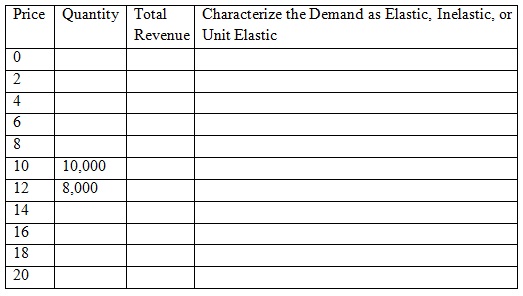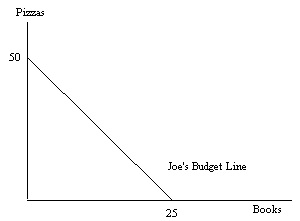Problem 1. CPI
Suppose you are given the following information to answer this set of questions.

For this problem assume that the market basket is defined as 1 hammer, 1 lawn mower, 1 unit of groceries for the year, and 2 bicycles. Note in this problem you may want to use a calculator and round all numbers to the nearest hundredth.
a. Compute the cost of the market basket for each year.
i. Cost of market basket in 2005 = ____________________________
ii. Cost of market basket in 2006 = ____________________________
iii. Cost of market basket in 2007 = ______________________
iv. Cost of market basket in 2008 = ____________________________
b. Calculate the CPI four times. Use 2005 as the base year the first time, then use 2006 as the base year, then 2007 as the base year, and finally 2008 as the base year. Complete the following table with your calculated values.

c. Calculate the inflation rate between each year using 2005 as the base year. Fill in the following table based on your calculations.
Time Period Inflation Rate using 2005 as the Base Year
2005-2006
2006-2007
2007-2008
d. Calculate the inflation rate between each year using 2006 as the base year. Fill in the following table based on your calculations.
Time Period Inflation Rate using 2006 as the Base Year
2005-2006
2006-2007
2007-2008
e. Calculate the inflation rate between each year using 2007 as the base year. Fill in the following table based on your calculations.
Time Period Inflation Rate using 2007 as the Base Year
2005-2006
2006-2007
2007-2008
f. Calculate the inflation rate between each year using 2008 as the base year. Fill in the following table based on your calculations.
Time Period Inflation Rate using 2008 as the Base Year
2005-2006
2006-2007
2007-2008
g. Compare your answers in parts (c), (d), (e), and (f) and explain the reasoning behind your results.
Problem 2. CPI
Answer the following set of questions using this CPI information for an economy.
Year CPI with Base Year 2005
2005 100
2006 105
2007 110
2008 115
a. Joe’s nominal income in 2006 is $100,000. What must his nominal income be in 2008 in order for his real income to be unchanged?
b. Mary’s real income in 2007 was $80,000. What must her nominal income be in 2008 in order for her real income to be unchanged?
c. Mike borrows $1000 in 2005 and repays this loan in 2006. Mike pays the lender $1060 in 2006. What is the real value of this payment in 2006 using 2005 as the base year? What nominal interest rate is Mike paying for this loan? What real interest rate is Mike paying for the loan?
d. The Fisher equation provides an approximation of the real interest rate. The Fisher equation is r = n – the expected inflation rate where r is the real interest rate and n is the nominal interest rate. Use this Fisher equation to provide an approximation of the real interest rate for Mike’s loan in problem 2c.
Problem 3. Elasticity
Suppose you know that when the price of the good is $10, the quantity demanded of the good is 10,000 units. And, if the price increases to $12, the quantity demanded of the good falls to 8,000 units.
a. Calculate the price elasticity of demand using the above information. Use the midpoint or arc elasticity of demand in your calculation. Is demand elastic or inelastic in this region of the demand curve?
b. Suppose you know that the demand curve for the product is linear. What is the price elasticity of demand for this good when the price is $10? Use the point elasticity of demand definition in your calculation.
c. Suppose you know that the demand curve for the product is linear. What is the price elasticity of demand for this good when the price is $12? Use the point elasticity of demand definition in your calculation.
d. Using the demand curve you found in part (b) complete the following table. In the table circle that line in the table where total revenue is maximized.

Problem 4. Elasticity
Suppose Our Town Metro is the government operated transit service for our community. Currently Our Town Metro is debating what it should do about bus fares for next year. Suppose the goal of Our Town Metro is solely to increase its revenue from the sale of bus fares. Our Town Metro estimates that the demand for bus fares is given by the equation
Q = 50,000 – (50,000/3)P
Where Q is the number of bus fares and P is the price of a bus fare.
a. Suppose the current price of a bus fare is $1.00. What is your advice to Our Town Metro about its fare price for the coming year? Explain your answer.
b. Suppose the current price of a bus fare is $2.00 What is your advice to Our Town Metro about its fare price for the coming year? Explain your answer.
Now, suppose there are actually two types of Metro riders: Students and Workers. The demand for Metro rides by students is given by the equation
Qstudents = 20,000 – 10,000P
The demand for Metro rides by workers is given by the equation
Qworkers = 30,000 – 10,000P
c. Derive the market demand curve for Metro rides based upon the above information. Hint: you will need two different equations to describe this demand curve and you will need to specify the range of prices or quantities for each equation.
d. Our Town Metro is debating whether it should charge a single fare price to both students and workers or whether it should charge students a different fare than the workers’ fare. Which option would result in greater revenue for Our Town Metro? Explain your answer and provide numeric values for the two pricing options.
Problem 5. Elasticity
a. You know that the cross-price elasticity of demand for doughnuts and coffee is equal to -1.5. From this elasticity value you conclude that doughnuts and coffee are ________. Suppose that the price of coffee increases by 10%. Given the cross-price elasticity of demand for these two goods you estimate that the percentage change in the quantity demanded of doughnuts will be _______ (make sure you identify whether the % change is positive or negative in your answer).
b. You know that the income elasticity of demand for doughnuts is equal to 1.2 You read in the newspaper that the economy has entered a recession and you are interested in how this recession will affect your doughnut business. Holding everything else constant, what do you anticipate will happen to the demand for doughnuts? Are doughnuts a normal good given this information?
Problem 6. Consumer Theory
Suppose Joe’s income is $500 and he spends all of his income of either books or pizza. Joe’s budget line is depicted in the graph below. Assume all books sells at the same price.

a. Given the above information, what is the price of a book?
b. Given the above information, what is the price of a pizza?
c. Provide an equation for Joe’s budget line recalling that the budget line can generally be written as I = PxX + PyY where I is income, Px is the price of good X, X is the quantity of good X, Py is the price of good Y, and Y is the quantity of good Y.
d. Suppose Joe’s income doubles as do the prices for books and pizzas. Describe the effect of these changes on Joe’s budget line.
e. Assume that Joe’s income is at the initial level and his budget line is the one depicted in the above graph. Suppose Joe devotes 60% of his income to the purchase of books in order to maximize his satisfaction. How many books and pizzas will Joe consume given this information?
f. Now, suppose the price of books increases by $5 while the price of pizza is unchanged. Draw a graph that depicts Joe’s initial budget line (BL1) and his new budget line (BL2). Can Joe afford his initial consumption bundle? Explain your answer.
g. What is the equation for Joe’s new budget line given the information in part (f)?
h. Assume the information given in part (f). Suppose Joe optimizes his utility by consuming 30 pizzas when he faces BL2. How many books does Joe purchase if he maximizes his utility while facing BL2?
i. Assume the information given in parts (f) and (h). Suppose that Joe would need to have his income increased to $630 in order for him to have the same utility as he had initially while paying the new price for books. Facing the new prices and with this compensated income, Joe would choose to consume 10 books. How many pizzas would Joe choose to consume?
j. Assume the information given in parts, (f), (g) and (h). Provide a measure of Joe’s substitution effect and his income effect from the information you have been given and the calculations you have done.